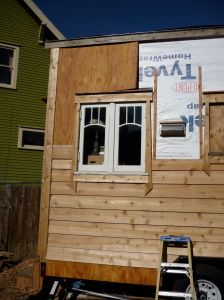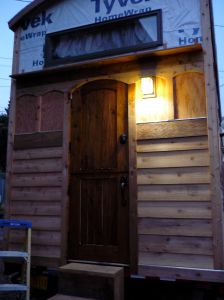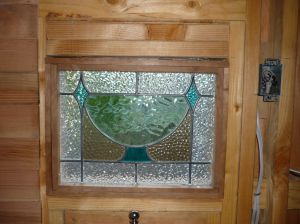Blog Archives
Through Monsoon and Sun
After the massive, 5x-record-breaking rains we had in September that showed us where all the leaks were, the house has been thoroughly caulked and weatherproofed. Oddly I discovered that we haven’t taken any pictures yet of the finished siding on the long wall, so we’ll post that soonish. We both really like the window frame style we chose, even though it is one more reason our house will not have a unified style. The French doors have proved to be the most challenging of the wall openings we have in terms of waterproofing, so beware if you choose to add them to your house! May be one of the reasons why many tiny houses with French doors have a porch covering them…
We did put up the lap siding, board and batten on the front door side, along with a small drip edge, although nothing is stained yet, so it is various shades of cedar. The white areas will soon be covered with cedar shingles, which will be gorgeous when done!
We also made good progress on the 12 v system, which is important in order to have the water pump up and running. Part of that included the biggest dang breaker I’ve ever seen, for 275 amps (!) DC:
 That breaker weighs several pounds. We procured it to protect the inverter/charger from excessive 12v input, whether from the batteries, solar panels, wind turbines, or generators. We also made a breaker cabinet for the 12 and 120 v breakers feeding the inverter/charger for easy access from the outside:
That breaker weighs several pounds. We procured it to protect the inverter/charger from excessive 12v input, whether from the batteries, solar panels, wind turbines, or generators. We also made a breaker cabinet for the 12 and 120 v breakers feeding the inverter/charger for easy access from the outside:
And made a bunch of custom cables to run between the batteries, breakers, and inverter/charger. Got a lot of raised eyebrows at a Big Box store when I asked for 2/0 wire. (Guy looks at chick, thinks she’s confused, and says, “You mean, like 12 or 14 gauge wire with 2 wires? Like, you know, the kind in your house?” Sees my face, then asks, hesitatingly, “Or you mean, really big wire?” Similarly, the lady at checkout asked me no less than three times what I was using the wire for, but first asked me if I bought it there. That wire weighed a lot and made about a 30″ dia loop when coiled, so you guess how likely it would be that I brought it from home. When I told her it was for a 12v system, she looked even more befuddled). Bought their last 15 feet of the stuff, and proceeded to find that they do not carry terminals in 2/0 size, only #2 size. Auto shops are not helpful, as they carry #2, at the largest, of both wire and terminals, in my experience. Ace Hardware to the rescue! They carry an array of all-copper, 2/0 ring terminals, for a cheaper price than buying off Amazon. Man I love those guys. We could have bought even bigger terminals, or in different styles if we wanted, because they’re that cool, and carry it all. Then to attach said terminals to the cables. For this, there are many professional-grade, hydraulic-assisted lug crimpers out there, and they cost a few hundred dollars. Harbor Freight sells one with individual dies for the differing gauges for $80, online only. My dad told me about this mysterious metal block thingy with a plunger on it that you hit with a hammer, and after much hunting, found a single specimen at a big-box auto shop. It truly is just a heavy pin in a jig that you use to smash the lug with when you hit it with a hammer, called an “auto lug crimper.” Works great though, and cost $21. Ended up saving quite a bit of $$ making the cables ourselves, not to mention 2/0 cable is not too flexible, so you want exact lengths anyway. It’s stupid the things you view as triumphs, but we were pretty proud of that.
Successfully tested the gas lines, which held pressure beautifully after 5 min of final tightening. Used a little gauge from the Big Box store on a plumbing tee with a bicycle pump fitting on one end. A beautiful sight after several hours:
Also installed the last stained-glass window, over the kitchen sink. Like the other one, it is an antique from an English pub. We thought the goblet design was appropriate for the kitchen, set into a custom-made new cherry wood frame, with room left to install a second plate of glass on the outside to protect it and insulate better.
And we talked to Monty, and he mentioned a few things that we will have to do before he *might* be able to pass us on inspection of the house for a homemade “park trailer” – vents are required on the sinks and tub, which he said can be “auto vents” which vent via a tee just past the P-trap to a side wall, and are one-way vents. They look pretty inexpensive and easy to install, so we will probably try to do that. He also said a 30amp main breaker in the breaker panel is necessary, which I was thinking was a good idea anyway. And lastly, besides the smoke, CO, and LP/gas alarms which we already have, a “5BC” rated fire extinguisher, mounted near the front door, in a clearly visible place, is required. So maybe there is hope yet that we can have our house certified as a park trailer. We’ll keep you posted.
Overall, we have not once felt that our house was too small for our needs, though. Which is funny, because that seems to be everyone’s concern. Our difficulties currently lie in working full time while completing our house, when neither of us are a plumber, electrician, sider or roofer. Perhaps it will be different once we have more built-in furniture, but we don’t think so. We’ll just be happy to be living less like transients.
And if you are fecophobic or otherwise squeamish, do not read this last portion. For those who are not, and/or are contemplating a composting toilet system, read on:
We have gone through several phases of toilet-care philosophy. Much like Cat, featured on The Tiny House Blog recently here, we have decided that much of the toilet hype is just that. Phase 1 was the Humanure Handbook philosophy, which goes something like: “Put it all in one bucket, cover with several inches of dry sawdust or similar, and then throw into a massive compost pile when the bucket is full.” Except since we are on a small, narrow lot, there is nearly nowhere to place a compost pile that wouldn’t be too close to a neighbor’s yard, so we were going to garbage-bag it into the trash. Problem was that unless you covered every single time (regardless of #1 or #2) with a large amount of mulch, it stunk, bad. If you did, the bucket filled up within a few days, and let’s face it, no one wants to be the one to change the bucket out, or deal with a really massive compost pile if you don’t have lots of property.
Phase 2:
Separation of #1 and #2, cover #2 with mulch, hang a separate cup in the front of the bucket for #1. Worked really well to decrease changeover of the bucket. Discovered that humans make a tremendous amount of urine daily, and that almost all of the bad smell from the toilet was from the urine, not #2. So instead, now we are emptying the pee pot daily, in loo of the bucket weekly (haha, get it? moving on…). Not a huge amount better, but slightly. If you slack off, there is, as the Scandinavians delicately put it, “A sulfurous odor associated with outhouses.” Not terribly nasty, but not really nice, either. So, we thought, there is a reason all those fancy expensive toilets (Airhead, Nature’s Head, etc) have urine separation and a closed urine collection system! Whaddya know? But, as Cat pointed out, those guys are spendy, and not the greatest. Some people we know with a tiny house have a Nature’s Head, and they said the urine bottle fills up almost daily, so aside from an improvement in smell, maintenance levels are the same.
Phase 3:
Should have happened a long time ago. Looked high and low for a reasonably-priced urine separation/diversion setup. EcoVita.net has the best selection of the main brands we have found in the US. Separett (Swedish company, of course) seems to make all of the low-end, basic urine diverting setups, but the cheapest ones are hideous, and $120 if you include shipping. A lot for a bit of plastic, but I guess that’s because of importation costs since the US can’t seem to get their you-know-what together, pardon the pun. They can market them in the US as “emergency toilets” and thereby get around all of the stupid laws that abound regarding home toilet composting. Interestingly, in continental Europe Separett markets a model called “Dass Isak” which is a holdover model from their former competitor Isak. Although mostly made of styrofoam, it has a fitted lid, an attractive shape, and a one-piece urine diverting seat out of white plastic, instead of bright blue. It is even cheaper than the “Privy Kit” but Separett politely informed me that it is being phased out and is not exported to the US. The only company that was willing to export it seemed to charge a “stupid American tax” of around $40, plus shipping, which came to around $200. Sadly not worth it. What we opted for was available on Ebay for $50, and is a basic black plastic funnel that flares out so you can nail/attach it to the underside of your toilet housing, and has a neck that fits a standard-sized hose. It seems to be made by a company out of the UK. Ours will arrive later this month, and we are inordinately excited about it. We are seriously thinking about running said hose to the tub drain just past the P-trap, and never having to empty any urine container, inside or out, ever again. It seems that everybody eventually arrives at the conclusion of running the urine directly to a drainage bed, or to a large holding vessel outside, that is then emptied periodically. Urine doesn’t stink until it’s sat for a bit, so much like grey water, I suspect storage, for any length of time, is not a good idea. Here is the big fuss:
Many Scandinavian webpages recommend “washing down” the urine with a small amount of water, to dilute it so it doesn’t burn any plants in your drain field and also to prevent crystal buildup. We think that is folk wisdom to be followed. Incidentally, the Scandinavians seem to be really passionate about their outhouses (just look up “Torrdass”), their history, styles, and construction, so they seem to know what’s going on better than most. I’ve read that bamboo is especially tolerant of high nitrogen and salts, so not sure if it’s better to make a native rain garden to drain our mixed waste water to along with excess rain runoff, or have a separate mulched and planted area for it. Ideas on that front are welcome!




